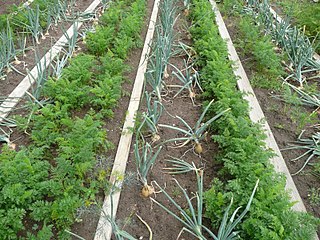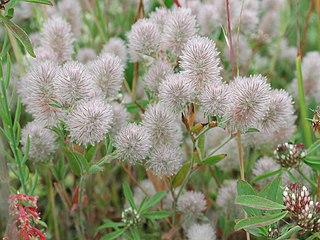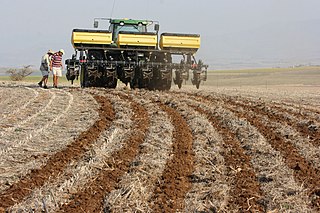
Tillage is the agricultural preparation of soil by mechanical agitation of various types, such as digging, stirring, and overturning. Examples of human-powered tilling methods using hand tools include shoveling, picking, mattock work, hoeing, and raking. Examples of draft-animal-powered or mechanized work include ploughing, rototilling, rolling with cultipackers or other rollers, harrowing, and cultivating with cultivator shanks (teeth).

Crop rotation is the practice of growing a series of different types of crops in the same area across a sequence of growing seasons. This practice reduces the reliance of crops on one set of nutrients, pest and weed pressure, along with the probability of developing resistant pests and weeds.

Forage is a plant material eaten by grazing livestock. Historically, the term forage has meant only plants eaten by the animals directly as pasture, crop residue, or immature cereal crops, but it is also used more loosely to include similar plants cut for fodder and carried to the animals, especially as hay or silage.

In agriculture, a green manure is a crop specifically cultivated to be incorporated into the soil while still green. Typically, the green manure's biomass is incorporated with a plow or disk, as is often done with (brown) manure. The primary goal is to add organic matter to the soil for its benefits. Green manuring is often used with legume crops to add nitrogen to the soil for following crops, especially in organic farming, but is also used in conventional farming.

In agriculture, cover crops are plants that are planted to cover the soil rather than for the purpose of being harvested. Cover crops manage soil erosion, soil fertility, soil quality, water, weeds, pests, diseases, biodiversity and wildlife in an agroecosystem—an ecological system managed and shaped by humans. Cover crops can increase microbial activity in the soil, which has a positive effect on nitrogen availability, nitrogen uptake in target crops, and crop yields. Cover crops may be an off-season crop planted after harvesting the cash crop. Cover crops are nurse crops in that they increase the survival of the main crop being harvested, and are often grown over the winter. In the United States, cover cropping may cost as much as $35 per acre.

A mulch is a layer of material applied to the surface of soil. Reasons for applying mulch include conservation of soil moisture, improving fertility and health of the soil, reducing weed growth and enhancing the visual appeal of the area.

In agriculture, polyculture is the practice of growing more than one crop species in the same space, at the same time. In doing this, polyculture attempts to mimic the diversity of natural ecosystems. Polyculture is the opposite of monoculture, in which only one plant or animal species is cultivated together. Polyculture can improve control of some pests, weeds, and diseases while reducing the need for pesticides. Intercrops of legumes with non-legumes can increase yields on low-nitrogen soils due to biological nitrogen fixation. However, polyculture can reduce crop yields due to competition between the mixed species for light, water, or nutrients. It complicates management as species have different growth rates, days to maturity, and harvest requirements: monoculture is more amenable to mechanisation. For these reasons, many farmers in large-scale agriculture continue to rely on monoculture and use crop rotation to add diversity to the system.

Dryland farming and dry farming encompass specific agricultural techniques for the non-irrigated cultivation of crops. Dryland farming is associated with drylands, areas characterized by a cool wet season followed by a warm dry season. They are also associated with arid conditions, areas prone to drought and those having scarce water resources.

No-till farming is an agricultural technique for growing crops or pasture without disturbing the soil through tillage. No-till farming decreases the amount of soil erosion tillage causes in certain soils, especially in sandy and dry soils on sloping terrain. Other possible benefits include an increase in the amount of water that infiltrates into the soil, soil retention of organic matter, and nutrient cycling. These methods may increase the amount and variety of life in and on the soil. While conventional no-tillage systems use herbicides to control weeds, organic systems use a combination of strategies, such as planting cover crops as mulch to suppress weeds.

Nutrient management is the science and practice directed to link soil, crop, weather, and hydrologic factors with cultural, irrigation, and soil and water conservation practices to achieve optimal nutrient use efficiency, crop yields, crop quality, and economic returns, while reducing off-site transport of nutrients (fertilizer) that may impact the environment. It involves matching a specific field soil, climate, and crop management conditions to rate, source, timing, and place of nutrient application.

Soil conservation is the prevention of loss of the topmost layer of the soil from erosion or prevention of reduced fertility caused by over usage, acidification, salinization or other chemical soil contamination.

Trifolium arvense, commonly known as the hare's-foot clover, rabbitfoot clover, stone clover or oldfield clover, is a flowering plant in the bean family Fabaceae. This species of clover is native to most of Europe, excluding the Arctic zone, and western Asia, in plain or mid-mountain habitats up to 1,600 metres (5,200 ft) altitude. It grows in dry sandy soils, both acidic and alkaline, soil with dry-mesic conditions and is typically found at the edge of fields, in wastelands, at the side of roads, on sand dunes, and opportunistically in vineyards and orchards when they are not irrigated.

A beneficial weed is an invasive plant that has some companion plant effect, is edible, contributes to soil health, adds ornamental value, or is otherwise beneficial. These plants are normally not domesticated. However, some invasive plants, such as dandelions, are commercially cultivated, in addition to growing in the wild. Beneficial weeds include many wildflowers, as well as other weeds that are commonly removed or poisoned. Certain weeds that have obnoxious and destructive qualities have been shown to fight illness and are thus used in medicine. For example, Parthenium hysterophorus native to northern Mexico and parts of the US has been an issue for years due to its toxicity and ability to spread rapidly. In the past few decades, though, research has found that P. hysterophorus was "used in traditional medicine to treat inflammation, pain fever and diseases like malaria dysentery." It is also known to create biogas that can be used as a bioremediation agent to break down heavy metals and other pollutants.
Soil biodiversity refers to the relationship of soil to biodiversity and to aspects of the soil that can be managed in relative to biodiversity. Soil biodiversity relates to some catchment management considerations.

Strip-till is a conservation system that uses a minimum tillage. It combines the soil drying and warming benefits of conventional tillage with the soil-protecting advantages of no-till by disturbing only the portion of the soil that is to contain the seed row. This type of tillage is performed with special equipment and can require the farmer to make multiple trips, depending on the strip-till implement used, and field conditions. Each row that has been strip-tilled is usually about eight to ten inches wide.
The term cropping system refers to the crops, crop sequences and management techniques used on a particular agricultural field over a period of years. It includes all spatial and temporal aspects of managing an agricultural system. Historically, cropping systems have been designed to maximise yield, but modern agriculture is increasingly concerned with promoting environmental sustainability in cropping systems.
Soil management is the application of operations, practices, and treatments to protect soil and enhance its performance. It includes soil conservation, soil amendment, and optimal soil health. In agriculture, some amount of soil management is needed both in nonorganic and organic types to prevent agricultural land from becoming poorly productive over decades. Organic farming in particular emphasizes optimal soil management, because it uses soil health as the exclusive or nearly exclusive source of its fertilization and pest control.

Natural farming, also referred to as "the Fukuoka Method", "the natural way of farming", or "do-nothing farming", is an ecological farming approach established by Masanobu Fukuoka (1913–2008). Fukuoka, a Japanese farmer and philosopher, introduced the term in his 1975 book The One-Straw Revolution. The title refers not to lack of effort, but to the avoidance of manufactured inputs and equipment. Natural farming is related to fertility farming, organic farming, sustainable agriculture, agroecology, agroforestry, ecoagriculture and permaculture, but should be distinguished from biodynamic agriculture.
Mechanical weed control is a physical activity that inhibits unwanted plant growth. Mechanical, or manual, weed control techniques manage weed populations through physical methods that remove, injure, kill, or make the growing conditions unfavorable. Some of these methods cause direct damage to the weeds through complete removal or causing a lethal injury. Other techniques may alter the growing environment by eliminating light, increasing the temperature of the soil, or depriving the plant of carbon dioxide or oxygen. Mechanical control techniques can be either selective or non-selective. A selective method has very little impact on non-target plants where as a non-selective method affects the entire area that is being treated. If mechanical control methods are applied at the optimal time and intensity, some weed species may be controlled or even eradicated.
This glossary of agriculture is a list of definitions of terms and concepts used in agriculture, its sub-disciplines, and related fields. For other glossaries relevant to agricultural science, see Glossary of biology, Glossary of ecology, Glossary of environmental science, and Glossary of botanical terms.















